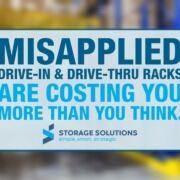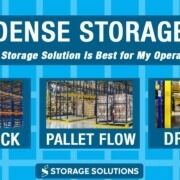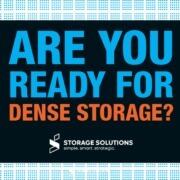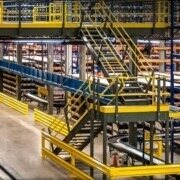Drive-in and drive-thru racks are popular dense storage solutions for companies looking to increase storage capacity within their facilities. Typically, these solutions are best applied in environments with a high volume of pallets stored on hand with a low number of SKUs.
The two racking styles are very similar in that they store pallets on rails, which are attached to uprights that create deep aisles of storage that allow forklifts to drive in or through the system to select or drop off a pallet. However, they differ in that drive-in racking requires the forklift to back out of the aisle (making ideal for last-in, first-out (LIFO) inventory management). In contrast, drive-through racking allows the driver to enter through either end of the system (making some people think it ideal for first-in, first-out inventory management). Operationally though, using drive-through racking for FIFO inventory often creates lots of additional product touches and adds cost. Drive-through racking also requires an aisle for travel on both sides of the system, making drive-in racking a higher-density option.
In suitable environments, these styles of racking can undoubtedly be beneficial. They can help support storage density efforts with a relatively low initial cost. In fact, in an environment where steel prices are not as volatile as they are now, drive-in and drive-thru racks are typically around a third of the price-per-position as other dense storage solutions like pushback rack, pallet flow, or the use of pallet shuttles. After all, there are no moving parts and no mechanical components in drive-in and drive-through racking; it is static.
But in the wrong environment, drive-in and drive-thru racks can lead to unforeseen expenses, slower fulfillment times, and poor utilization of cubic storage space. Ironically, these negative consequences were likely all the problems the evaluator was attempting to solve in the first place.
How does that happen? To start, evaluators are looking at the wrong bottom line.
Because drive-in and drive-thru racking is the lowest-cost dense storage racking system, a decision-maker will look at and their area and determine that they can fit the same number of bays of drive-in as, say, pallet flow. However, because the cost of the former is roughly 30-40% of the latter, they will default to choosing the cheaper option.
That low initial cost looks good to the decision-makers looking at a project as an open-and-shut project but not part of an overall operational strategy. While that initial bottom-line number is appealing, they may not be considering that cost-based decision may end up with a wrong application or poorly utilized storage system. Operational costs can soar when drive-in and drive-thru racks are misapplied. Dense storage design is better managed with a long-term approach with a more strategically applied solution.
The trick with drive-in and drive-thru racks: you want to keep utilization high, so you need to keep the same product in each lane – front to back and the top. Ideally, you want more than one lane worth of product for utilization purposes – filling the entire depth and height of the storage system – for each SKU being stored. But what happens when orders change and SKU proliferation hits? Now, you may be storing fewer of a particular product, a greater variety, and those dedicated lanes start getting SKUs mixed. Now you may have to turn, rotate, move-and-return other pallets to get a pallet you need to select, adding several more touches-per-pick and increasing your operational costs in the process.
Now, consider that drive-in and drive-thru racking is a popular storage solution for the food-and-beverage industry, where temperature-controlled storage is frequent. You have to figure in lot codes, date codes, and other requirements to maintain the product’s integrity. It can be a real challenge to manage these inefficiencies while keeping utilization high, operational costs low, and discipline to those codes.
How Do I Know if I Have a Utilization Problem with My Drive-In or Drive-Thru Racking?
The challenge with knowing whether your drive-in or drive-thru racking is operating at its fullest potential – or if another strategy should be considered – lies in the fact that you need to be looking for that magic utilization number to know if it is truly working for your operations (or not). If you are not actively seeking to maximize your space, you may not notice that you are underperforming.
However, if you have a significant share of drive-in or drive-through racks and are finding yourself in need of expediting your orders, or you are looking at adding dense storage solutions, give us a call first.
Misapplications of drive-in and drive-thru racking can cause many unforeseen expenses and slow down pick processes intended initially for efficiency. Our team of experts knows how crucial operational flow is to a company’s long-term bottom line. We know the challenges associated with rising operational costs-per-pick and have the experience to design and provide solutions uniquely designed to meet your needs, now and with an eye toward future growth.





